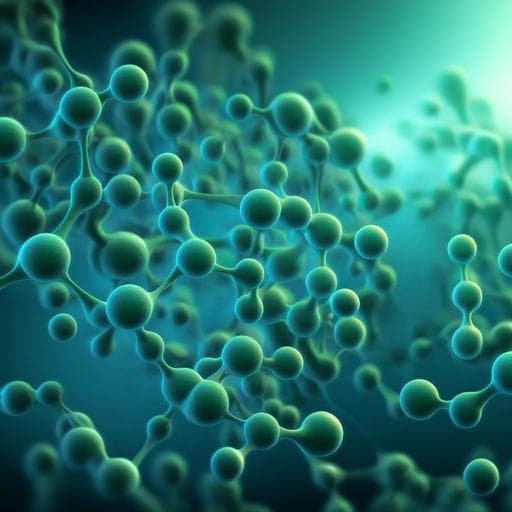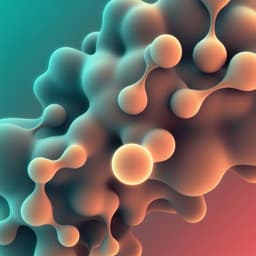
Medicine and Health
Dietary resistant starch enhances immune health of the kidney in diabetes via promoting microbially-derived metabolites and dampening neutrophil recruitment
M. Snelson, D. Deliyanti, et al.
Discover how dietary-resistant starch (RS) emerges as a potential therapeutic tool against diabetic kidney disease in a groundbreaking study by Matthew Snelson and colleagues. RS supplementation not only reduces albuminuria but also enhances essential microbially-derived metabolites and modulates immune responses in the kidneys of diabetic mice.
~3 min • Beginner • English
Introduction
The study investigates whether dietary resistant starch (RS), a fermentable fiber, can protect against diabetic kidney disease (DKD) by modulating microbially derived metabolites and renal immune responses. Prior work shows dietary fiber benefits renal health, yet intake is often inadequate in people at risk of kidney disease. RS, particularly type 2, is widely studied, fermentable by colonic bacteria, and produces short-chain fatty acids (SCFAs) with immunomodulatory effects. However, the effects of RS on microbially derived metabolites and immune cell populations in diabetes, especially in the kidney, are not fully defined. The purpose is to evaluate how RS supplementation affects portal vein metabolites, intestinal permeability, and renal immune cell infiltration/activation, and to determine whether these changes translate into improved kidney function in a murine model of type 2 diabetes.
Literature Review
The paper outlines that dietary fiber interventions improve renal health markers in CKD. Despite this, fiber intake is inadequate among those with or at risk for kidney disease. RS is classified into five types based on resistance to α-amylase digestion, with type 2 most studied; it ferments more slowly than other fibers (e.g., inulin, FOS, GOS), potentially reducing GI discomfort. RS has shown promise against DKD in prior studies, but mechanisms remain under investigation. Much prior focus has been on SCFAs (acetate, propionate, butyrate), products of microbial fermentation with immunomodulatory actions through receptors on immune cells. There is a gap in understanding RS effects on microbially derived metabolite production in diabetes and on renal immune cell dynamics. The study positions itself to address these gaps.
Methodology
Design and animals: Male db/db (type 2 diabetes model) and db/m (non-diabetic controls) mice (BKS.Cg-Dock7m+/+ Leprdb/J) were obtained at 4 weeks, acclimatized for 2 weeks, and started diets at 6 weeks of age. Mice were housed under controlled conditions with ad libitum food and water. Weekly body weight and random blood glucose were measured. Sample size per group was based on pilot data to detect a 100 g/mol change in urinary albumin-creatinine ratio (α=0.05, power 0.8). Ethics approval was obtained (AMREP AEC E1487/2014/B). Diets: For 10 weeks, mice received either a semi-pure RS diet (25% Hi-maize 1043, equating to 12.5% RS type 2) or a matched control diet; both were isocaloric with matched protein and fat. Non-diabetic mice received control diet (db/m), diabetic mice received control (db/db) or RS-supplemented diet (db/db RS). Two cohorts were run with identical diets: Cohort 1 for renal immune cell flow cytometry, albuminuria, urinary C5a, portal vein metabolites and permeability markers; Cohort 2 for renal and intestinal histology and intestinal tight junction gene expression. Metabolic caging and biospecimen collection (Cohort 1): At week 9 (age 15 weeks), mice underwent 24-h metabolic caging for urine collection (albumin, creatinine, C5a) and water/food intake assessment. Urinary albumin (ELISA, Bethyl E90-134), urinary C5a (R&D DY-1250), and urinary creatinine (Roche 03263991190 via Cobas Integra 400 Plus) were measured. At endpoint, mice were anesthetized and portal vein blood collected (with sodium citrate), centrifuged, plasma stored at -80°C; both kidneys were harvested for flow cytometry. Cohort 2 endpoint: Mice were anesthetized, exsanguinated, and plasma collected; kidneys were fixed for histology; the GI tract was dissected, measured (length/weight), flushed, with jejunum/ileum fixed for histology and snap-frozen tissues for gene expression. Flow cytometry (Cohort 1): Single-cell suspensions from both kidneys were prepared using mechanical dissociation, Collagenase IV digestion, Percoll gradient, RBC lysis, and Fc block. Antibody panel: CD45 (BV786), CD11b (AF700), Ly6C (BV605), C5aR1 (FITC), Ly6G (PE), plus fixable live/dead stain. Acquisition was on BD FACSCanto II, analysis via FACSDiva. Targeted metabolomics and permeability markers (Cohort 1): Portal vein plasma LBP (ELISA, Abcam ab269542) and endotoxin (LAL-based assay, Pierce A39552) were measured. Targeted metabolomics was performed on portal vein plasma (no prior freeze-thaw) as previously described, with data analyzed in MetaboAnalyst (log-transformed, fold-change threshold 2, FDR 0.05). Renal histology (Cohort 2): PAS staining on 3-µm kidney sections; glomerulosclerosis scored 0–4; Glomerulosclerosis Index calculated. Imaging at 200x; blinded analysis via Image-Pro Plus. Renal immunohistochemistry (Cohort 2): 4-µm sections stained for fibronectin (DAKO AO245, 1:400) using standard peroxidase blocking, pepsin retrieval, Dako Superblock, overnight primary, biotinylated secondary, Vectastain ABC, DAB development, hematoxylin counterstain; quantified blinded. Intestinal histology (Cohort 2): 5-µm jejunum and ileum sections stained with H&E for villus height and crypt depth; Alcian blue and PAS for goblet cells; imaging at 100x; blinded measurements. Quantitative RT-PCR (Cohort 2): RNA extracted with TRIzol; cDNA via M-MuLV RT. TaqMan assays for ZO-1 (Tjp1) and JAM-A (F11r); SYBR Green for occludin (Ocin), claudins 1,2,3,4,5,7. Normalized to β-actin; ΔΔCT relative to db/m CON. Statistics: Outliers removed by ROUT (FDR 0.01). Normality via Kolmogorov-Smirnov. Parametric: one-way ANOVA with Tukey’s post hoc; non-parametric: Kruskal–Wallis with Dunn’s. Metabolomics analyzed in MetaboAnalyst 5.0 with thresholds above. Sample sizes: UACR and urinary C5a n=10–12; metabolomics and permeability n=5–12; flow cytometry n=4–5; histology n=11–16; RT-qPCR n=7–12.
Key Findings
- Kidney function: Diabetic db/db mice had elevated albuminuria vs db/m. RS supplementation reduced urinary albumin-creatinine ratio (p<0.05). Plasma creatinine was elevated in db/db vs db/m and was reduced with RS (p<0.001). Urine output was unaffected by RS. - Portal vein metabolomics: PCA showed db/db RS samples clustered closer to db/m than db/db controls. Uremic toxins (p-cresol sulfate, p-cresol glucuronide, indoxyl sulfate) were higher in db/db vs db/m, and were lowered in db/db RS vs db/db control. SCFAs (acetate, propionate, butyrate) were reduced by diabetes; in db/db mice, RS significantly increased propionate and butyrate (p<0.05) and increased acetate directionally. - Intestinal permeability: Plasma LBP and endotoxin were increased in db/db vs db/m (LBP p<0.01; endotoxin p<0.05). Among diabetic groups, RS reduced LBP by ~47% (p=0.08) and endotoxin by ~75% (not significant). - Renal immune profile (flow cytometry): Total leukocyte populations showed no clear difference between db/m and db/db, but RS decreased leukocytes in diabetic kidneys. Diabetes increased renal neutrophil frequency; RS supplementation reversed this increase. Neutrophil activation marker CD11b MFI was elevated in diabetes and reduced by RS. The proportion of C5aR1+ neutrophils was increased in diabetes and not elevated in db/db RS. Urinary C5a was increased in diabetes (p<0.0001) and reduced with RS (p<0.05). - Renal structure/fibrosis (Cohort 2): Diabetes increased combined kidney weight (p<0.01), glomerulosclerosis index (p<0.0001), and glomerular fibronectin deposition (p<0.05). RS did not change glomerulosclerosis or glomerular fibronectin. - Intestinal morphology: Diabetes increased villus height in jejunum and ileum (p<0.05); RS had no effect. Crypt depth and goblet cells per villus were unchanged across groups. RS increased cecum and colon length and weight (no change in small intestine). - Tight junction gene expression: In jejunum, diabetes decreased claudin-4 and claudin-7; RS ameliorated the decrease in claudin-7 and increased ZO-1 expression. In ileum, diabetes decreased claudin-7; RS reversed this and increased ZO-1 expression. In colon, diabetes did not alter claudin-7; RS increased expression of tight junction markers as reported (ZO-1 and occludin per Fig. 6).
Discussion
The findings demonstrate that dietary resistant starch improves renal functional markers in diabetic mice and is associated with a shift in portal vein microbially derived metabolites toward a non-diabetic profile. RS increased SCFAs, notably butyrate and propionate, which have established roles in maintaining intestinal barrier integrity and modulating immune responses. Consistent with this, RS reduced indicators of intestinal permeability (LBP, endotoxin), suggesting decreased translocation of pro-inflammatory microbial components. In the kidney, RS reduced neutrophil infiltration and activation (lower neutrophil frequency, decreased CD11b MFI) and decreased the proportion of C5aR1+ neutrophils, alongside reduced urinary C5a, indicating modulation of complement pathway activation. Together, these data support a mechanism in which RS-derived microbial metabolites improve gut barrier function and dampen systemic and renal inflammatory signaling, including complement-mediated neutrophil activation, thereby attenuating renal injury (albuminuria, plasma creatinine). The discussion highlights SCFA-mediated pathways (e.g., potential GLP-1 induction via FFAR2/GPR43) and reduction of uremic toxins (such as p-cresol sulfate) as plausible contributors to reduced oxidative stress and inflammation. Although RS did not alter established structural kidney injury (glomerulosclerosis, fibronectin) over the study duration, the immunomodulatory and permeability effects likely contribute to improved functional outcomes. These results underscore dietary RS as a non-pharmacologic strategy to modulate immunometabolic pathways relevant to DKD progression.
Conclusion
Dietary resistant starch supplementation in diabetic mice improved kidney function (reduced albuminuria and plasma creatinine), promoted a portal vein metabolite profile resembling non-diabetic mice (increased SCFAs; reduced uremic toxins), decreased intestinal permeability, and dampened renal inflammation (reduced neutrophil infiltration/activation and complement C5a/C5aR1 signaling). These benefits occurred without changes in glomerulosclerosis or glomerular fibronectin over the study period. The work supports RS as a therapeutic dietary approach to modulate microbially derived metabolites and immune responses to improve kidney health in diabetes. Future research should define causal pathways linking specific metabolites (e.g., butyrate) and complement signaling to renal outcomes, determine optimal RS types/doses, assess longer-term structural renal effects, and translate findings to human clinical studies.
Limitations
Limitations were not explicitly stated in the text.
Related Publications
Explore these studies to deepen your understanding of the subject.







